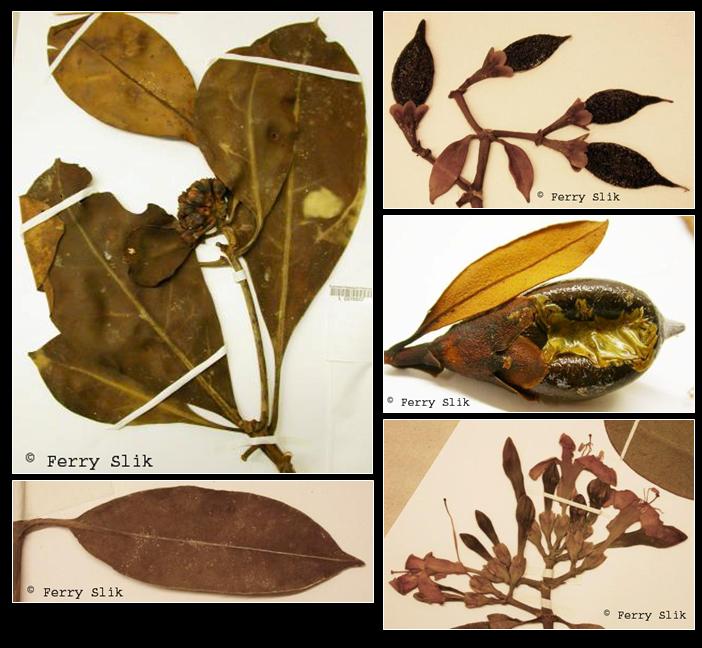Fagraea ceilanica Thunb., Vet. Acad. Handl. Stockh. 3 (1782)
Named after 'Ceylon', current Sri Lanka.Synonyms
Fagraea amboinensis Blume
Fagraea angiensis Kaneh. & Hatus
Fagraea archiboldiana Merr.
Fagraea birmanica Gandoger
Fagraea celebica Blume
Fagraea chinensis Merr.
Fagraea congesta Blume
Fagraea coromandelina Wight
Fagraea crassifolia Blume
Fagraea forstenii Blume
Fagraea fuscescens Blume
Fagraea gardeniaeflora Wernh.
Fagraea gardneri Thwaithes
Fagraea heterophylla Blume
Fagraea khasiana Benth.
Fagraea lanceolata Blume
Fagraea litoralis Blume
Fagraea loheri Merr.
Fagraea lutea Cammerl.
Fagraea macrodendron Gilg. & Bened.
Fagraea malabarica Blume
Fagraea malabarica Wight [Illegitimate]
Fagraea minor Reinw. ex Blume
Fagraea oblonga K. & G.
Fagraea obovata Wall.
Fagraea oxyphylla Miq.
Fagraea prainii Gandoger
Fagraea pyriformis S.Moore
Fagraea rahmatii Merr.
Fagraea rostrata Blume
Fagraea sasakii Hayata
Fagraea sparei Henders.
Fagraea splendens Blume
Fagraea ternatana Miq.
Gardenia heteroclyta J.König ex Blume
Hillia longiflora hort. ex Lem.
Solandra oppositifolia Moon
Willughbeia ceilanica Spreng.
Willughbeia obovata Spreng.
Winchia cirrhifera Gardner ex Thwaites
Diagnostics
Epiphytic climber which turns into an understorey tree up to 17 m tall and
20 cm dbh when mature. Stipules surrounding the twigs. Leaves opposite, simple,
penni-veined, glabrous, leathery. Flowers ca. 60 mm diameter, whitish to orange,
placed in branched inflorescences. Fruits ca. 40 mm long,
green-yellowish-whitish, berries.
Description
Epiphytic or (more rarely) terrestrial shrub, climber, or small tree, up to 17 m. Leaves very
variable as to shape and size, varying from ovate to obovate (to spathulate in the Deccan and
Ceylon) via oblong or oblong-obovate to narrowly lanceolate, 4.5-35 by 1.5-9 cm, fleshy or
coriaceous, base attenuate and decurrent, cuneate, or rounded to subcordate, apex rounded to acute,
usually (and mostly gradually) acuminate, acumen short to long and blunt to acute; nerves 4-8(-12)
pairs, inconspicuous or mostly invisible (only in the typical form from Ceylon and S. Deccan
slightly prominent beneath); petiole slender to robust, 0.5-3.5(-5) cm, exauriculate, the axillary
scale appressed to the twig or (more rarely) partly or entirely adnate to the petiole, mostly
inconspicuous, rarely somewhat broader than the petiole, 0.2-0.8(-1) cm long, usually rounded,
rarely truncate or emarginate, often slightly confluent between the leaves. Inflorescences dichasial,
branched from the base, usually rather dense, sometimes laxly thyrsoid and up to 15 cm long,
(1-)3-17-flowered; pedicels slender (then usually thickened towards the calyx) to stout, 0.2-3.5 cm
long; bracteoles 2, inserted from about halfway the pedicel to just below the calyx, very small to
c. 2.5 cm long (usually the more apical the larger), sometimes confluent at the base and together
enclasping the calyx. Calyx campanulate to slightly urceolate, 1-2.8(-4) cm long (in Assam 6¡ª7.5 mm),
connate for 1/4 to more than 1/2. Corolla widely to slenderly funnel-shaped, tube 2-5 cm
(in the typical form from Ceylon and SW. Deccan 8.5-10 cm). Anthers oblong to ovate, (3.5-)
5-7.5(-12.5) mm long, cells free at the base for 1/3-1/2. Stigma obconical, slightly cup-shaped to
peltate, 1-5 mm diameter. Fruits ovoid or ellipsoid to subglobular, 3-5 cm long (specimens from Assam
1.8 cm), slightly to strongly beaked, glaucous white (sometimes mentioned as being coffee brown
or black); calyx often warty-lenticellate, lobes appressed, spreading, or reflexed. [from Flora
Malesiana]
Ecology
Occupying a wide range of habitats, in open localities and along forest edges but also in
primary and secondary forests, both on dry and on marshy or periodically inundated soils, under
everwet as well as under seasonal conditions, from sea-level up to 2500 m. Fl. mainly in the dry
season, fr. in the rainy period.
Uses
Sometimes cultivated as an ornamental shrub.
Distribution
Tropical Asia, from Sri Lanka, India and South China to New Guinea.
Local names
Borneo: Akar sempirai, Kayu alah, Penungpang, Salang mapit, Seraya.
Lesser Sunda Islands: kikunteh, kiterong, kemrungen, kepitu, rauai kajarok.
Moluccas: papatjeda bangan, p. utan, pasi gunung, tonki utan, mengando.
New Guinea: kulaken (or kuleka).
Peninsular Malaysia: ara burong.
Philippines: bankalon, busalsal, kotongogan, malatunog, mamagon, panagang, pospusug, pukut.
Simalur: angilaan bilu, bani-bani, luam, olor arelah.
Sumatra: Kaju djottik.
